What printing techniques are available for rigid boxes?
Struggling with bland rigid boxes? Want stunning packaging but unsure how? We explore printing techniques to make your boxes stand out and grab attention.
Rigid boxes typically use printing techniques like offset lithography, digital printing, flexography, and screen printing. These are applied to the paper wrap before it’s attached to the box’s core structure. Finishing touches like foil stamping also add appeal.
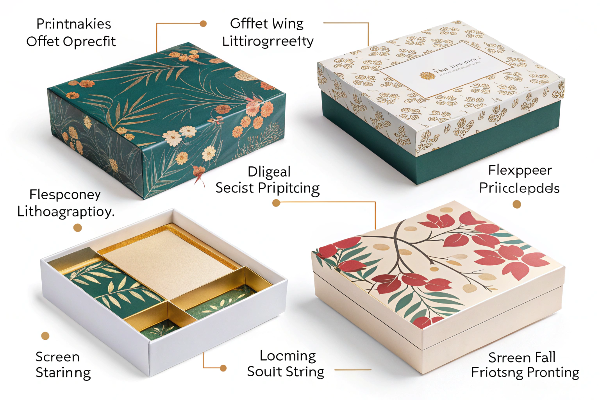
Choosing the right printing adds significant value to your packaging. It makes the box look attractive and feel premium. But printing is just one part of creating a great rigid box. Let’s look closer at the printing options and how they fit into the overall manufacturing process. Understanding this helps you make better choices for your packaging needs.
What are the different types of box printing?
Confused by printing jargon for boxes? Unsure which method fits your specific box project and budget limitations? Let’s clarify the main types used for packaging today.
Common box printing includes offset lithography (great for high quality, large runs), digital printing (good for short runs, personalized data), flexography (often used for corrugated boxes, labels), and screen printing (best for specialty inks, unique surfaces). Each has its advantages and disadvantages.
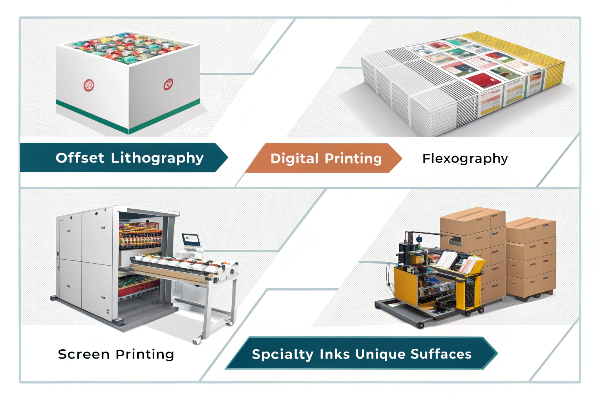
Let’s dive deeper into these methods. Understanding them helps you select the best fit for your rigid boxes.
Breaking Down Printing Methods
Choosing the right printing method depends on several factors: the quantity you need, your budget, the desired quality, and the material you’re printing on. For the paper wraps used on rigid boxes, offset and digital are very common.
- Offset Lithography: This method produces very high-quality, sharp images and consistent colors. It’s excellent for large production runs because once the printing plates are made, the cost per box becomes lower as quantity increases. It’s a popular choice for luxury packaging where appearance is key.
- Digital Printing: This is like using a very advanced office printer. There are no plates, making setup faster and cheaper for small quantities. It’s perfect for short runs, prototypes, or when you need variable data (like different names on each box). Quality is very good, though sometimes offset is preferred for exact color matching on huge runs.
- Flexography: Often used for printing on packaging like corrugated boxes or flexible labels. It uses flexible plates and fast-drying inks. While improving, it’s generally not the first choice for the super fine detail needed on high-end rigid box wraps, but might be used in specific cases.
- Screen Printing: This method applies ink through a mesh screen. It can lay down thick layers of ink, great for vibrant colors or printing on unusual surfaces. It’s slower and often more expensive per piece, so it’s typically used for specialty effects or shorter runs.
Here’s a simple comparison:
| Feature | Offset Lithography | Digital Printing | Flexography | Screen Printing |
|---|---|---|---|---|
| Best For | Large runs, High Quality | Short runs, Variable | Corrugated, Labels | Specialty inks, Vibrant |
| Setup Cost | High | Low | Medium | Medium |
| Per Unit Cost | Low (at high volume) | Higher | Low (at high volume) | High |
| Quality | Very High | High | Medium to High | Good (for its purpose) |
| Speed | Fast (once running) | Slower | Very Fast | Slow |
As a business in the graphic arts or paper converting industry 1, selecting the right print method impacts your final product and costs. Our Kylin Machinery customers often need solutions that work seamlessly with various high-quality printed wraps 2.
What is rigid printing?
Heard the term "rigid printing" but not quite sure what it means? Does it actually differ from standard printing methods? Let’s define this specific application clearly for you.
"Rigid printing" isn’t really a distinct printing method. It describes the process of printing designs onto paper wraps or sometimes directly onto substrates before they are made into rigid boxes. The focus is typically on achieving high quality for luxury packaging.

Let’s explore what makes printing for rigid boxes unique. It’s less about a special technique and more about the quality standard and application.
Understanding Printing for Rigid Boxes
The term "rigid printing" is industry shorthand. It emphasizes that the printing is intended for use in constructing rigid, non-collapsible boxes, which are often associated with premium products. Think of packaging for electronics, cosmetics, jewelry, or high-end gifts 3 2.
- Focus on Quality: Because rigid boxes often house luxury items, the print quality needs to match. This means sharp details, accurate colors, and flawless finishes are expected. Offset lithography is frequently chosen for this reason, especially for larger runs. Digital printing is also a strong contender, particularly for shorter runs or customization.
- Printing on Wraps: The most common approach is printing the design onto a sheet of paper or specialty material. This printed sheet, called a wrap, is then glued and folded around the structural greyboard or chipboard core of the box during manufacturing. This allows for complex, high-resolution graphics.
- Direct Printing (Less Common): While technically possible to print directly onto the chipboard before assembly, it’s less common for high-end rigid boxes. Achieving premium quality on thick, sometimes uneven board is challenging. Printing on a separate wrap generally yields better results.
- Integration with Finishing: "Rigid printing" often goes hand-in-hand with finishing techniques like foil stamping, embossing, debossing, spot UV coating, or lamination. These add texture, shine, and a tactile element, further enhancing the perceived value. Our machines, like the Auto hot stamp and thumb cutter 4, can integrate some finishing steps.
Essentially, rigid printing focuses on creating visually stunning and durable packaging. The chosen print method must deliver the quality needed for these high-value applications. Our Kylin rigid box machines are designed to assemble these boxes perfectly, preserving the quality of your chosen print and finish 5.
How to manufacture rigid boxes?
Want sturdy, premium-looking boxes but the manufacturing process seems complex? Need reliable and consistent production? We can break down the key steps involved in manufacturing rigid boxes efficiently.
Manufacturing involves cutting chipboard to size, often V-grooving the board for sharp edges, applying adhesive, precisely positioning and wrapping the printed paper wrap around the board, and neatly folding the edges. Automation using specialized machines, like ours at Kylin Machinery, ensures consistency, quality, and speed. 6
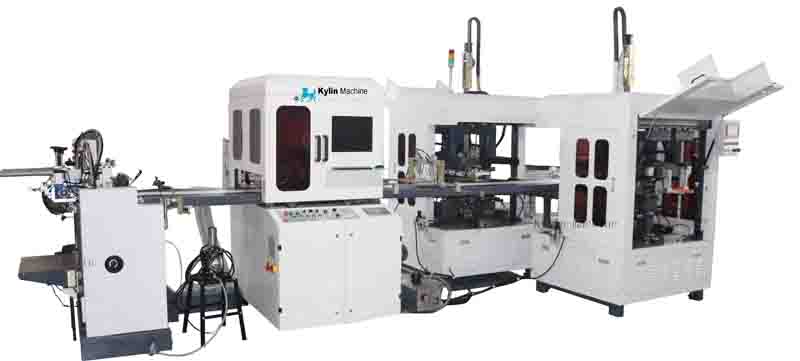
Let’s look closer at how these premium boxes are made, step-by-step. Knowing the process helps understand where quality is built in.
The Rigid Box Making Journey
Creating a high-quality rigid box involves several precise stages. Automation is key to efficiency and consistency, especially for larger volumes.
-
Board Preparation:
- Cutting/Slitting: The process starts with large sheets of greyboard or chipboard. A machine like our Cardboard Slitting Machine 4 5 cuts the board into the precise flat shapes needed for the box base and lid. Accuracy here is critical for the final box dimensions.
- Grooving (Optional but Recommended): For sharp, 90-degree corners and a high-end look, V-shaped grooves are cut partially through the board where the folds will be. Our Manual or Automatic Groove Machines 5 perform this task. Boxes made without grooving often use stay tape on the corners and can have slightly rounded or less defined edges 6. Grooving results in a much cleaner, more premium finish 6.
-
Wrap Preparation:
- The decorative paper wrap, already printed with the design, is cut to the correct size, allowing extra material for folding over the edges.
-
Assembly:
- Gluing: Adhesive is applied evenly to the printed wrap. Our Glue Spray Machine 4 5 can automate this, ensuring consistent application.
- Positioning & Wrapping: The grooved and cut chipboard pieces are accurately positioned onto the glued wrap. This is often done using a robotic spotter for high precision, a technology we specialize in at Kylin Machinery.
- Forming & Folding: The sides of the board are folded up, and the machine carefully wraps the glued paper around the edges, pressing it smoothly onto the board and folding the turnover neatly inside the box. Our range of Rigid Box Making Machines 3 5 automates this forming process efficiently for various box types, including standard, collapsible 3 5, round 3 4 5, and even polygonal shapes 3.
Using automated rigid boxes machinery like ours from Kylin Machinery ensures each box is made to the same high standard, minimizing errors and maximizing output for businesses in paper converting and graphic arts 1 2.
What printing method is used on cardboard?
Printing directly onto thick cardboard seems tricky, doesn’t it? Wondering which printing methods actually work best for different types of cardboard materials? Let’s explore the common techniques used.
The printing method depends heavily on the type of cardboard and its intended use. Flexography is very common for corrugated boxes (like shipping cartons). Offset lithography and digital printing are widely used for folding cartons (like cereal boxes). Screen printing works for special applications or very thick boards.
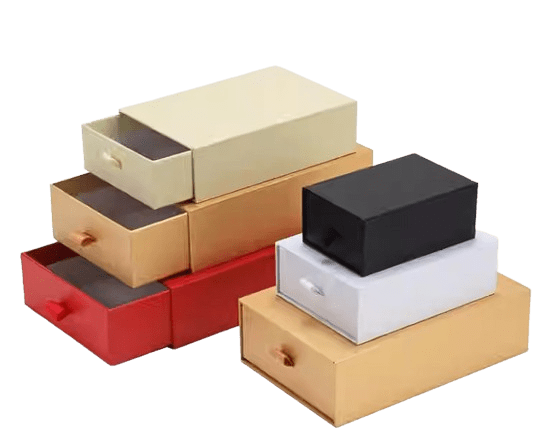
Let’s dive deeper into printing specifically on cardboard materials. It’s important to know that "cardboard" can mean different things.
Matching Print Method to Cardboard Type
Cardboard isn’t just one material. The main types relevant to packaging are corrugated board, folding carton board, and chipboard/greyboard.
- Corrugated Cardboard: This is the thick, wavy-layered board used for shipping boxes. Because its surface can be uneven and absorbent, Flexography is the most common printing method. It uses flexible rubber plates and fast-drying inks that work well on these surfaces. Quality has improved, but it’s generally simpler graphics and logos. Sometimes, a pre-printed liner sheet (using offset) is laminated onto the corrugated board for higher quality graphics.
- Folding Carton Board: This is the smoother, thinner board used for retail packaging like cereal boxes or cosmetic cartons. It offers a better printing surface. Offset Lithography is very popular here for high-quality graphics and large runs. Digital Printing is also increasingly used, especially for shorter runs, variations, or quick turnaround times.
- Chipboard/Greyboard: This is the dense, rigid board used as the structural core for rigid boxes. It’s typically not printed on directly for high-end packaging. Why? Because its surface is often rough and not ideal for premium graphics. Instead, as we’ve discussed, a separate, high-quality paper wrap is printed (using Offset or Digital primarily) and then glued onto the chipboard during the box making process 1.
So, while cardboard can be printed using Flexo, Offset, or Digital methods, the key takeaway for rigid boxes is that the printing usually happens on the paper wrap, not the core chipboard itself. This allows for the best possible print quality on the final luxury package. Our Kylin machines then expertly assemble these printed wraps onto the board structure 5.
Conclusion
Various printing techniques like offset and digital make rigid boxes look great. Understanding printing options and the manufacturing process, supported by quality machines like ours at Kylin Machinery, helps create premium packaging.

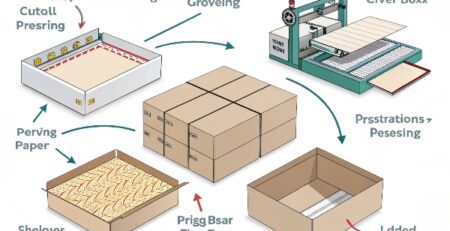
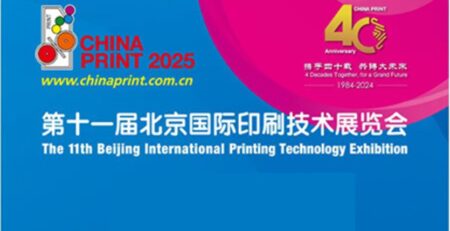


发表回复